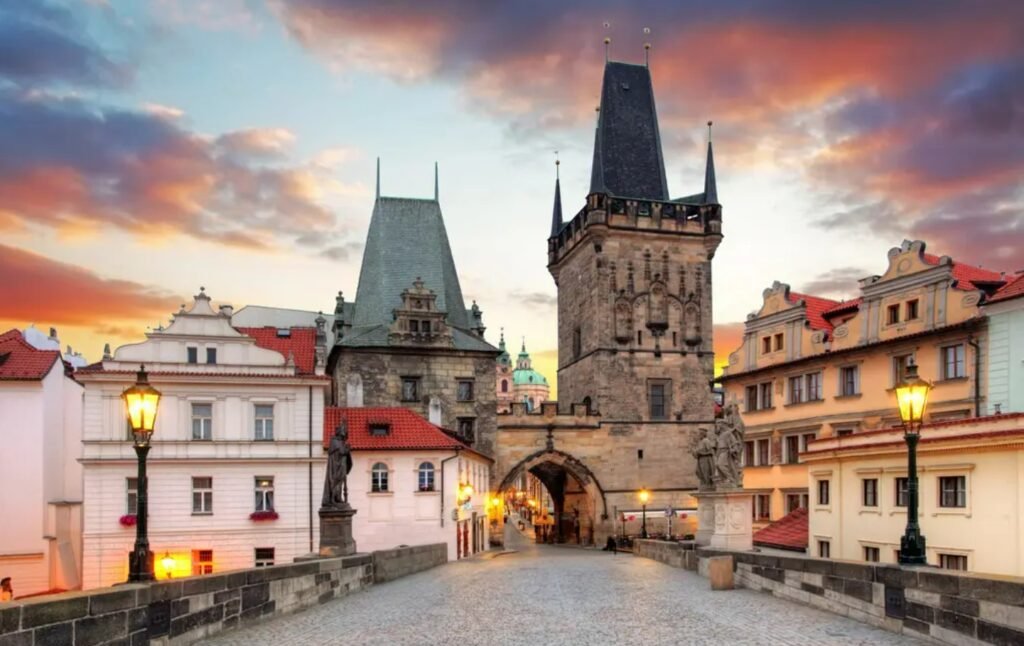Introduction to Prague:
Prague, the capital and largest city of the Czech Republic, is located at the heart of Europe along the banks of the Vltava River. This river acts like a green ribbon, dividing the city while ancient bridges seamlessly connect both sides.
Prague is a beautiful and historic hilly city, showcasing an array of architectural styles from various periods, with Baroque and Gothic being particularly prominent. The city’s architecture features richly varied rooftops and vibrant colors, earning it a reputation as one of the most beautiful cities in Europe.
Known as the “City of a Hundred Towers,” Prague offers a stunning skyline of peaks and spires that create a captivating panorama. When bathed in sunlight, the towers shimmer, and as Nietzsche once said, the only word to describe such a Prague is “mysterious.” In 1992, the historical center of Prague was designated a UNESCO World Heritage site.
Personal Impression:
Wandering through the cobblestone alleys that bear witness to centuries of history, I stumbled upon the bustling Old Town Square. The colorful, ancient buildings lined up before me, and the delightful sounds of European melodies drifted through the air, showcasing Prague’s breathtaking beauty!
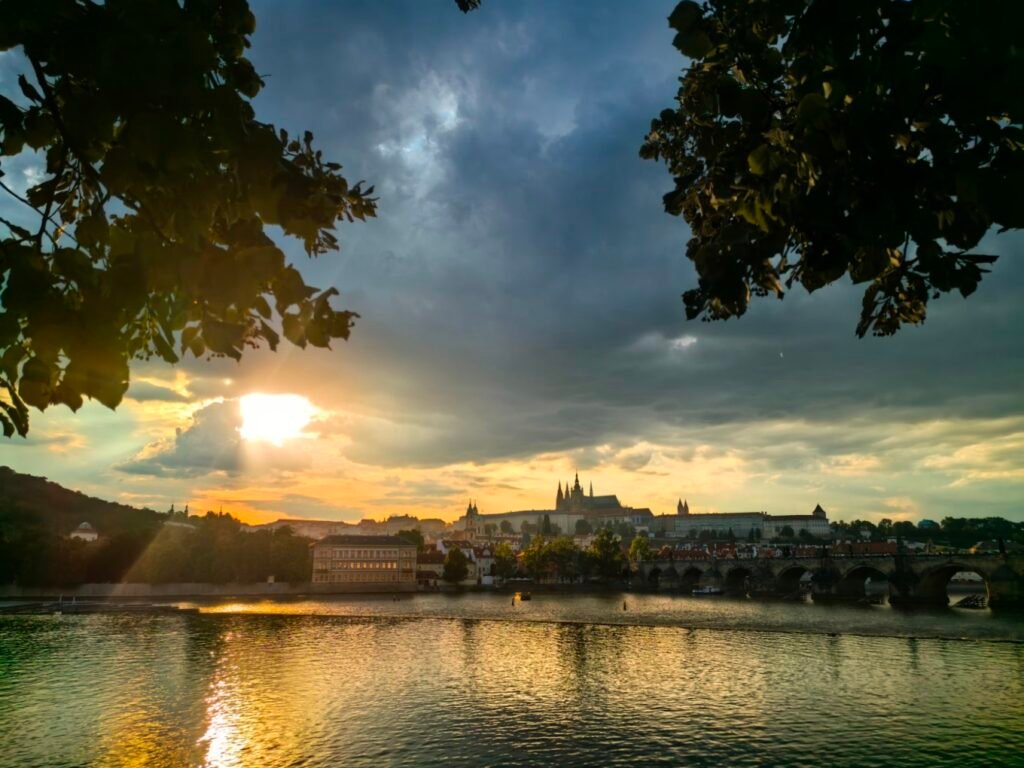

Best Time to Visit:
Prague experiences a typical temperate continental climate, with cold, dry winters and warm, humid summers. The best time to visit is from May to September. Rain is common throughout the year, so it’s advisable to carry rain gear. Music lovers should not miss the Prague Spring Festival in May and the Summer Festival in July.
Packing Tips:
In winter, be sure to pack warm clothing, while summer visitors should also bring rain gear due to the humidity. Since temperatures can vary significantly between day and night, it’s a good idea to bring a light jacket for outings.


Prague Overview:
Prague is one of the most beautiful cities in Europe, with the Vltava River flowing like a jade ribbon, dividing the city into two parts. The city is rich in diverse architecture from various historical periods, featuring unique castles and churches. The squares of Prague are also a remarkable highlight of the cityscape.
Most of Prague’s major attractions are located in the city center, concentrated in the Old Town, New Town, Castle District, and Lesser Town, making it ideal for walking tours. Philosopher Nietzsche once said, “When I think of a word to express music, I think of Vienna; when I think of a word to express mystery, I only think of Prague.” Spend a day strolling through this “City of a Hundred Towers,” and immerse yourself in the unique mystery that belongs only to Prague.
Prague Card:
The Prague Card is a four-day city sightseeing pass that allows free entry to 50 attractions, including Prague Castle, the Jewish Museum, and the Old Town Hall. It also offers at least a 30% discount at other sites. With the purchase of the Prague Card, you’ll receive a guide to the attractions, along with discounts for renowned performances and restaurants.
Prague Castle:
Perched on a hill overlooking the Vltava River, Prague Castle is the largest ancient castle in the world and one of the city’s most captivating attractions. Established in the 9th century, it has served as the residence of the Prague royalty for centuries. The castle complex showcases artistic treasures from various historical periods and has undergone multiple expansions, preserving many majestic buildings and historical artifacts. Today, it is also the official residence of the Czech president.
From the castle, you can enjoy stunning panoramic views of the entire city of Prague. The grounds feature three courtyards, ancient streets, galleries, gardens, and the largest Gothic church in the Czech Republic, St. Vitus Cathedral. The grandest halls are the Spanish Hall, used for presidential ceremonies and state banquets, and Vladislav Hall, where major political events like presidential inaugurations take place. In 1992, Prague Castle was designated a UNESCO World Heritage site.
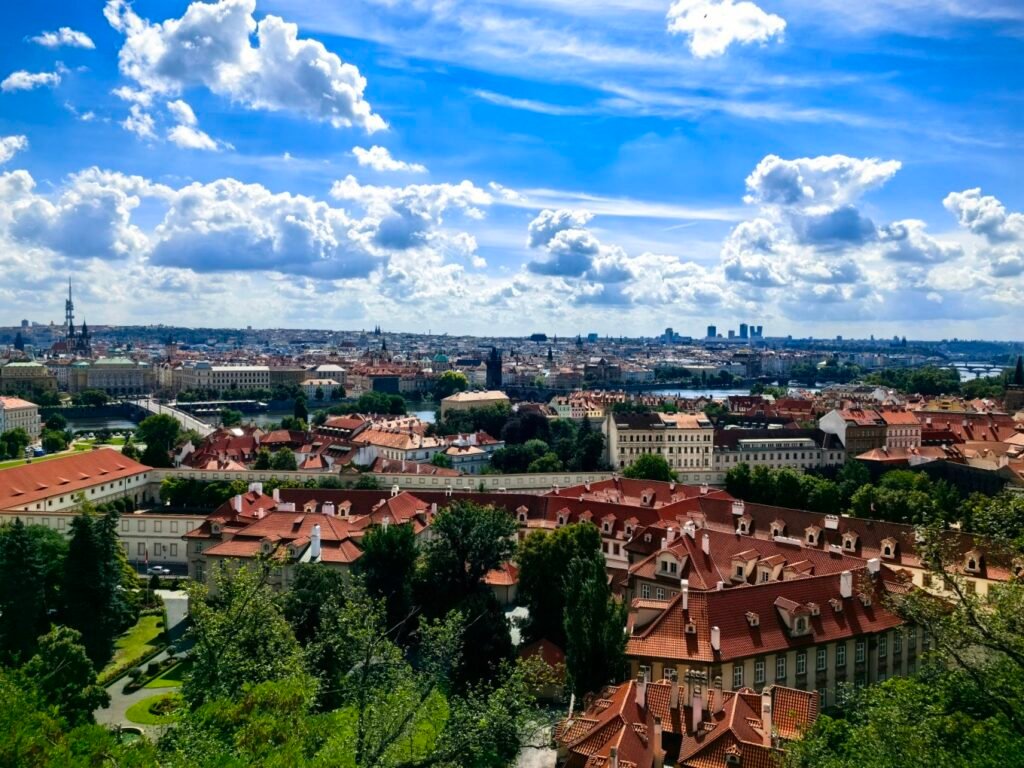

Old Town Square:
Prague’s Old Town Square is one of Central Europe’s most significant marketplaces from the 11th and 12th centuries, and it has been the site of pivotal political events that shaped the nation’s history. With a history spanning 900 years, the square is located between Wenceslas Square and Charles Bridge and is often bustling with tourists during the summer.
Surrounding the square are diverse architectural styles, including the Gothic Týn Church and the Baroque St. Nicholas Church. At the center stands the statue of Jan Hus, a prominent Czech religious reformer, commemorating the 500th anniversary of his death. The square is also dotted with various restaurants and cafes, making it a perfect spot for relaxation. Visitors can admire the famous astronomical clock on the exterior of the Old Town Hall, and the tower offers panoramic views of the Old Town. Old Town Square is Prague’s most renowned square, often simply referred to as Prague Square.
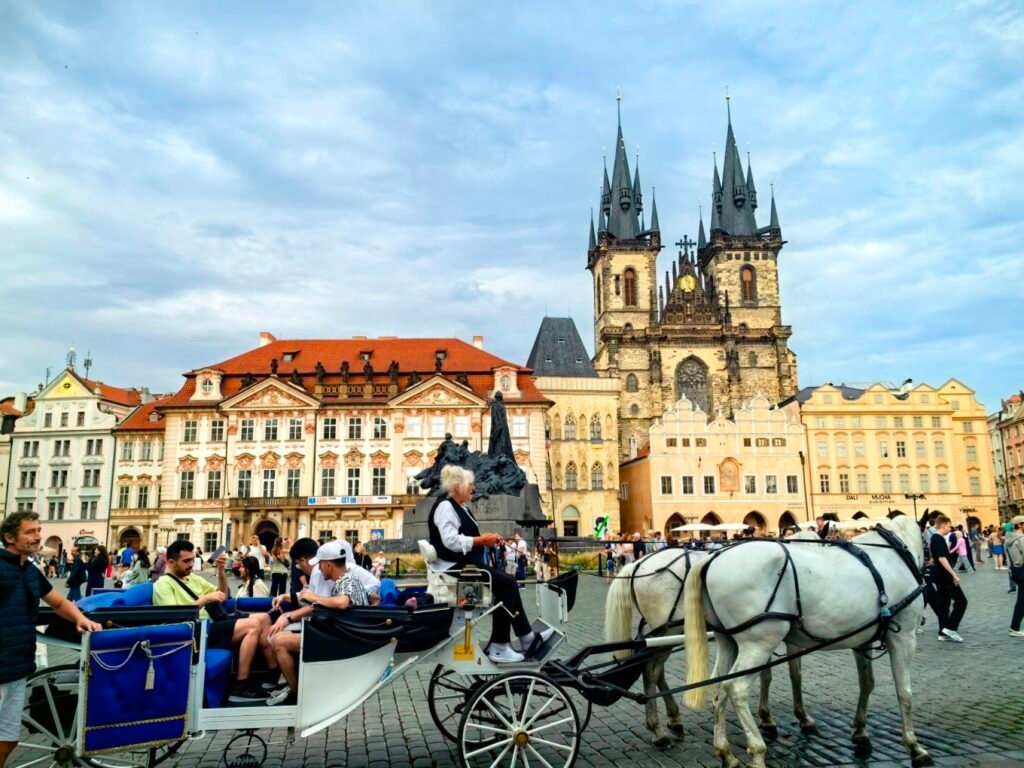
Týn Church:
Commonly known as the “Church of Our Lady Before Týn,” this iconic structure in Prague’s Old Town has served as the area’s main church since the 14th century. Nestled behind Old Town Square, it is the oldest building in the square, featuring a foreboding facade that contributes to its mystical aura. The church’s two 80-meter-high spires resemble burning torches, making it a focal point of the square that can be easily spotted from anywhere.
Týn Church is often likened to a fairy-tale fortress, with its dark gray exterior adding to its enigmatic charm. Originally built in the Romanesque style, it was later transformed into Gothic architecture and underwent significant renovations in the 15th century under Peter Parler, resulting in its current appearance. Legend has it that one spire represents Adam and the other Eve. After 1620, the church’s exterior and altar were enhanced with Baroque elements, including numerous sculptures and paintings of Jesus, further enriching its artistic significance.


Charles Bridge:
Built in 1357, Charles Bridge is the most artistically significant stone bridge of the 14th century and the most beautiful ancient bridge spanning the Vltava River in Prague. The bridge features 16 pillars, connecting Prague Castle on one end with the Old Town on the other. Adorning the bridge are 30 statues of saints, masterpieces by Czech Baroque artists from the 17th and 18th centuries, earning it the title of “Europe’s Open-Air Baroque Sculpture Gallery.” While the original statues have been moved to museums, most have been replaced with replicas.
On the right side of the bridge, the eighth statue depicts St. John of Nepomuk, the bridge’s guardian. The railing features a gold cross, marking the spot where St. John was allegedly thrown off the bridge. Legend has it that touching the golden cross will bring you lifelong happiness.
Charles Bridge has historically been the route for coronation parades of kings. Today, it serves as a vibrant stage for artists, featuring performances and craft demonstrations, making it a showcase of Prague’s artistic spirit. Visitors can purchase various artworks, including watercolor paintings of the bridge and marionettes dressed in traditional Czech costumes and royal attire.
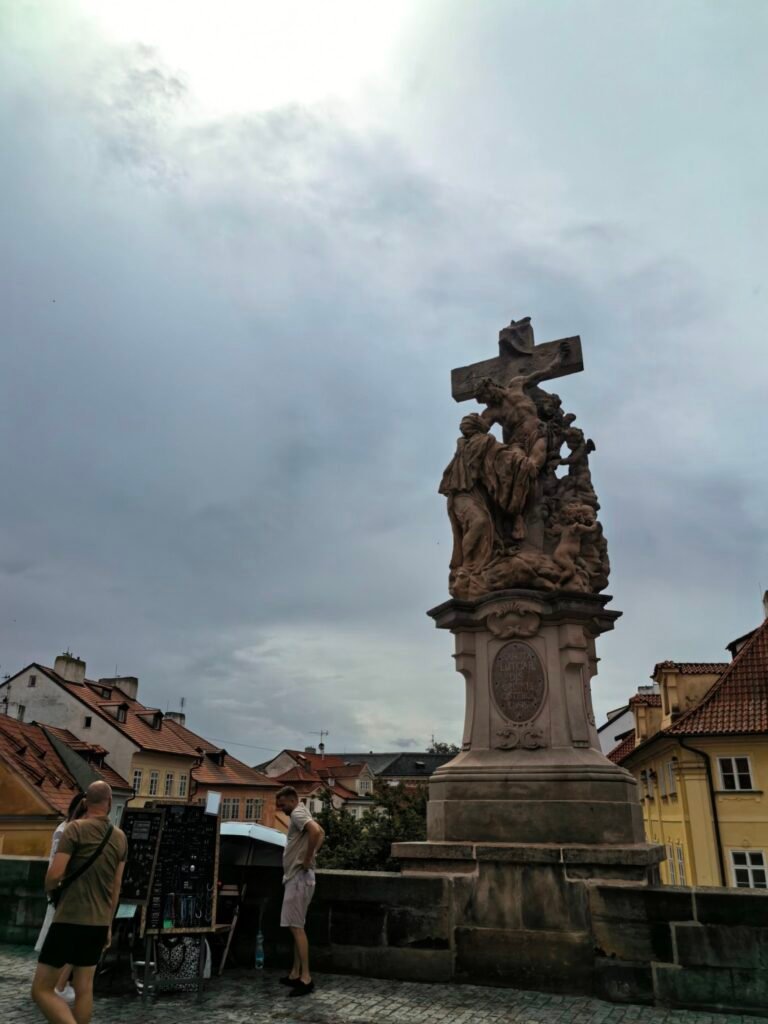
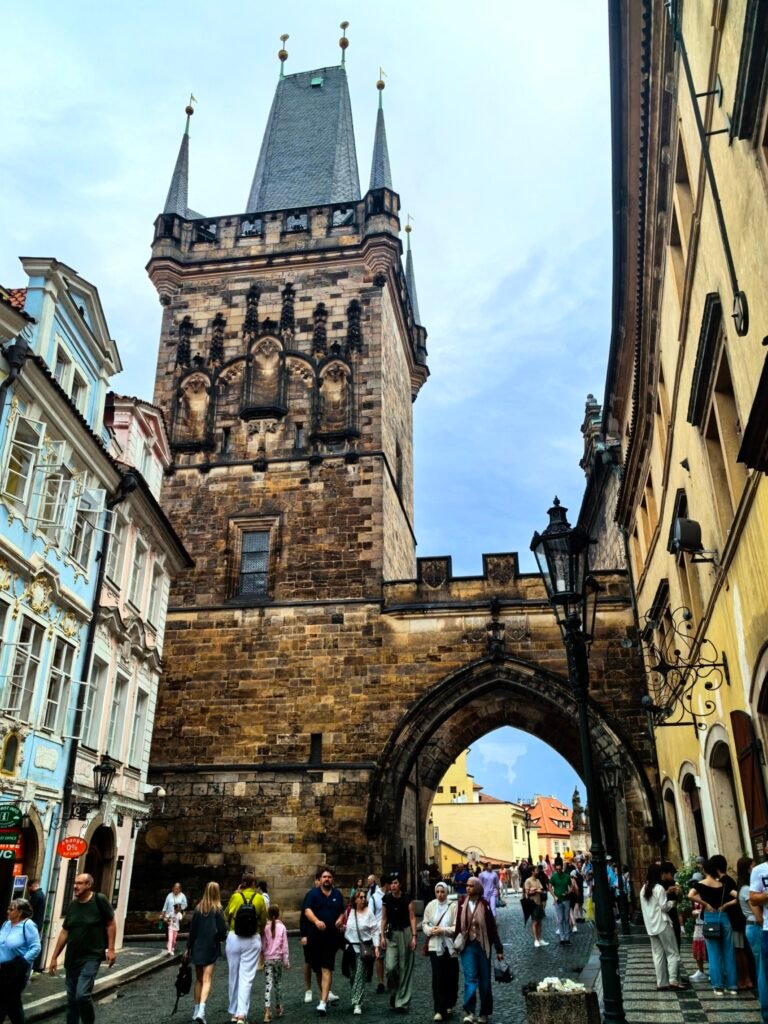
Wenceslas Square:
Wenceslas Square is the cultural and commercial heart of Prague’s New Town, boasting a rich history of over 600 years. Unlike a traditional square, it resembles a long, narrow boulevard lined with elegant classical buildings from the early 20th century, filled with various shops, making it the city’s most vibrant commercial district. This lively area has even earned the nickname “the Champs-Élysées of Prague.”
Originally one of the three markets planned by Charles IV when he established New Town, Wenceslas Square has long served as a vital center for trade and social gatherings, bustling day and night. Over time, however, it has transformed into a forum for public expression, witnessing numerous protests and demonstrations by the Czech people against government policies. It holds significant historical importance, as it has been the site of events defending national independence and protesting against invasions, giving it a unique place in the hearts of the Czech people.
St. Vitus Cathedral:
Located within Prague Castle, St. Vitus Cathedral is a stunning example of Gothic architecture and the largest, most significant church in the Czech Republic. It houses the tombs of many Bohemian kings and has been the site of coronation ceremonies for emperors, earning it the title of “treasure of architecture.” Among its treasures is the pure gold crown of Charles IV, the Holy Roman Emperor of the 14th century, along with his golden orb and scepter.
The cathedral’s tower features a Renaissance-style bell, and it offers one of the best panoramic views of Prague. Climbing the 287 steps to the top rewards visitors with breathtaking sights of the city’s famous towers. Once you finally catch your breath at the summit, the stunning view of the “City of a Hundred Spires” makes the effort truly worthwhile.
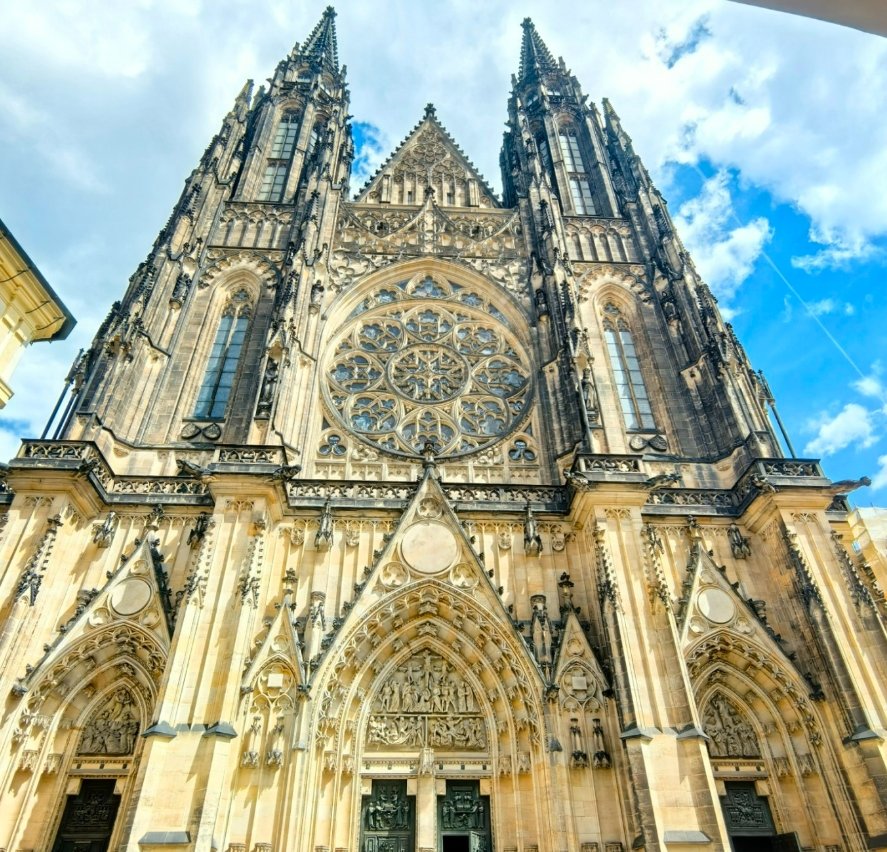

Powder Tower:
The Powder Tower is a Gothic city gate located in Prague’s Old Town and is one of the city’s most iconic landmarks. Constructed in 1475, it exemplifies typical Gothic architecture and was modeled after the Old Town Bridge Tower on Charles Bridge. It is one of the original 13 gates of Prague, and it remains the only one still standing.
Originally, the tower was intended as a coronation gift from the city council to the king, providing a connection to the royal palace via a small bridge. However, before its completion, King Vladislav Jagellonsky moved his residence to Prague Castle. Despite this, the Powder Tower retained its significance for the monarchs, as they continued to pass through it to reach St. Vitus Cathedral for their coronation ceremonies until 1836.
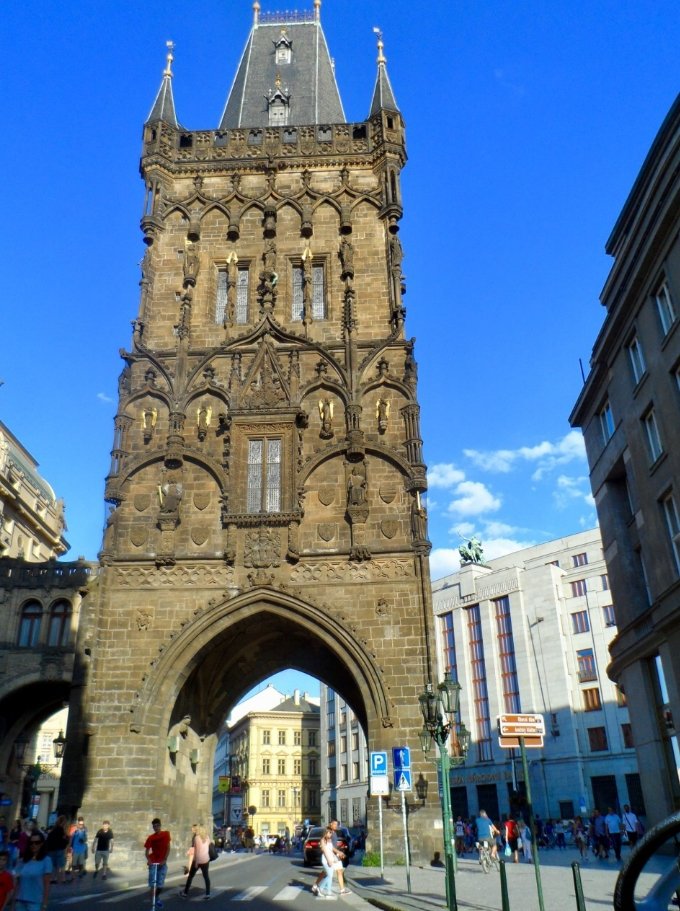
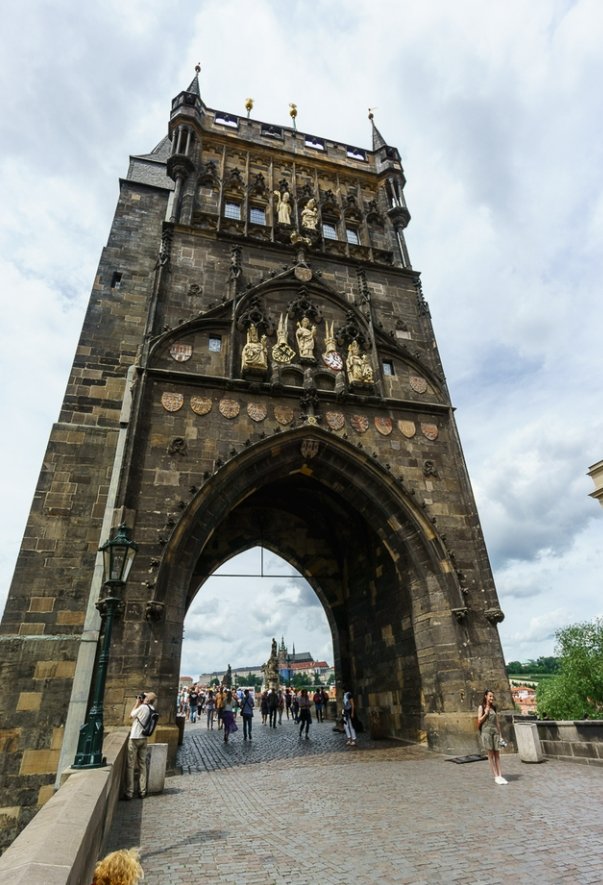
Old Town Hall and Astronomical Clock:
The Old Town Hall, established in 1338, once served as the royal court. After royal members moved to Prague Castle in the late 15th century, the hall fell into disuse for centuries until it was repurposed as a cultural center in 1911. It symbolizes Prague’s first city autonomy, with the famous mosaic mural “Homage to Prague” by artist Alfons Mucha adorning the main entrance, depicting the city’s rich history.
On the southern wall of the Old Town Hall is the renowned medieval Astronomical Clock, a popular tourist attraction. Built in 1410, this exquisite self-striking clock is still accurate, often used by locals to check their watches. Designed based on the geocentric model, the clock’s face makes one complete revolution each year, while the inner dial completes a full rotation daily. Every day at noon, twelve apostles appear from the clock, with six turning left and six turning right, followed by a rooster’s crow, signaling the clock chimes to announce the time.
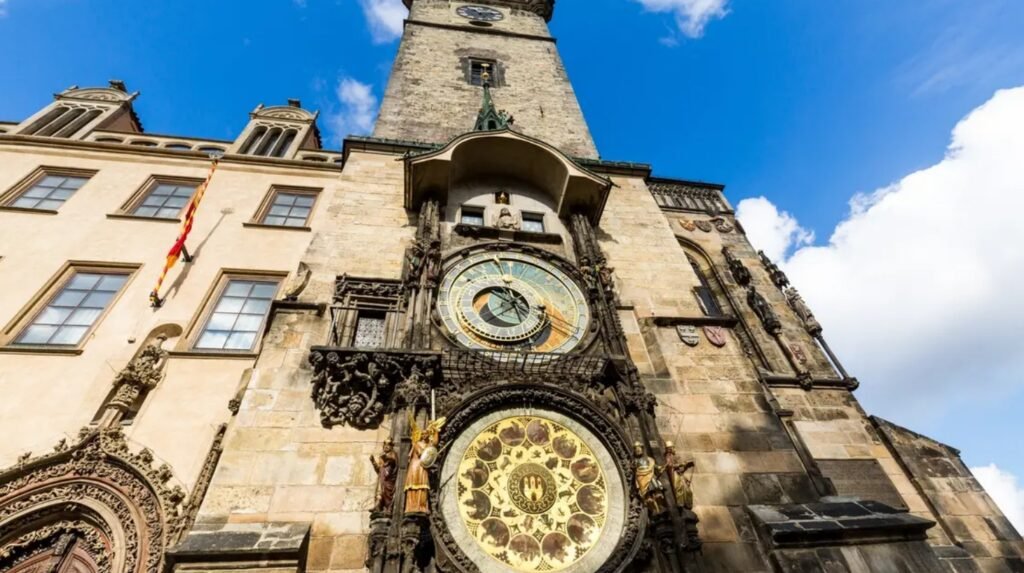
Golden Lane:
Golden Lane, nestled between St. George’s Church and the Toy Museum, is a charming little street reminiscent of a fairy tale, lined with quaint cottages. Originally home to servants and craftsmen, it earned its name due to the alchemists who gathered here to work for the king. By the 19th century, it had fallen into disrepair and become impoverished, but in the mid-20th century, it was revitalized into a delightful shopping area. Each shop offers a variety of souvenirs and handmade crafts, including wooden toys at No. 16, tin soldiers at No. 20, and hand-painted clothing at No. 21. The most picturesque spot is No. 19, with its lovely garden.
Golden Lane gained fame as the residence of famed writer Franz Kafka, who lived at No. 22 in 1916. At that time, Kafka was just a bank clerk who appreciated the tranquil environment. He rented the space for 20 crowns a month, where he quietly completed lesser-known works like “The Country Doctor” and “The Report to an Academy.” Notably, historical novelist Marie Kahl was a resident at No. 12.
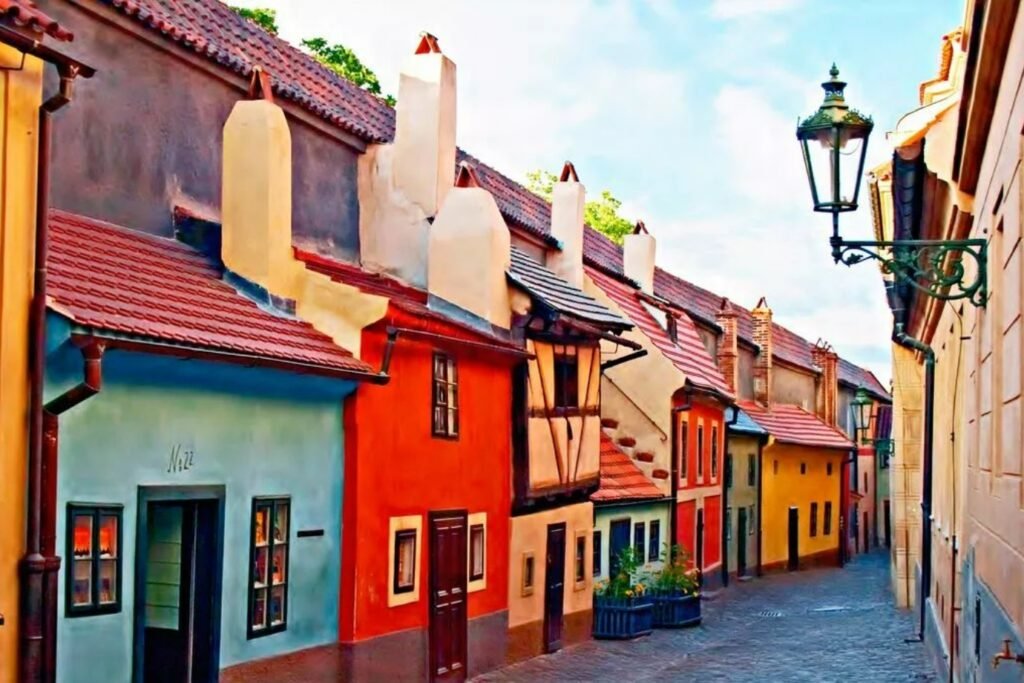
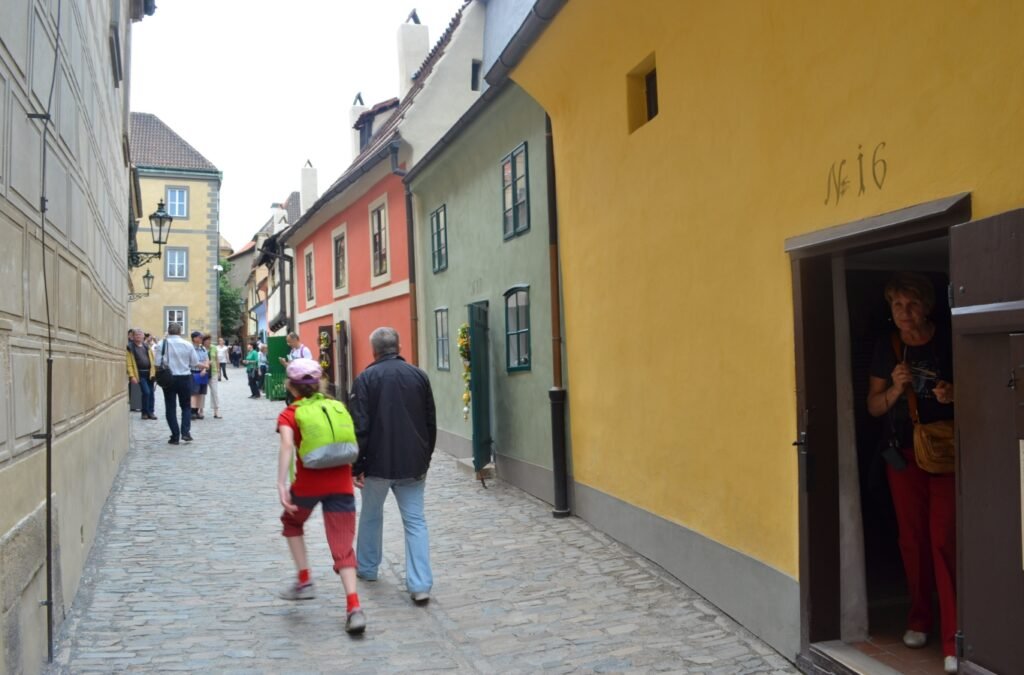
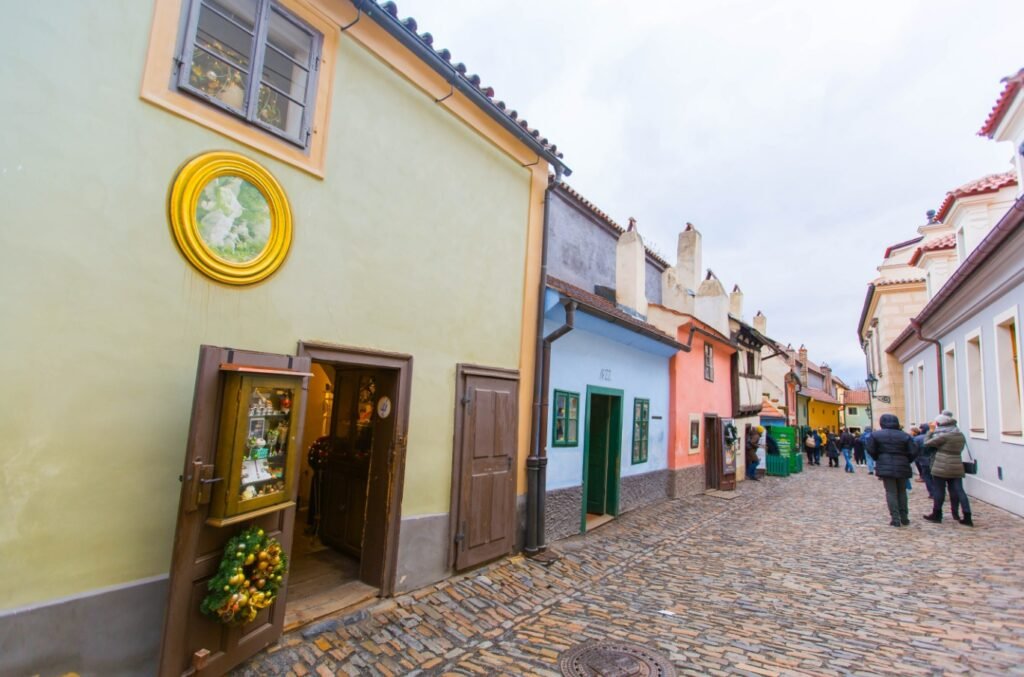
Vyšehrad
Vyšehrad is the birthplace of Prague, steeped in the beautiful legend of a noble princess and a handsome farmer falling in love. It was destroyed in the early 15th century, but you can still see the existing structures like St. Paul’s Church and the Garden of St. Martin. The most famous feature of Vyšehrad is its cemetery, where many of the most prominent families in Czech history are laid to rest. Perched on a cliff, Vyšehrad offers one of the best viewpoints to overlook the entire city of Prague.
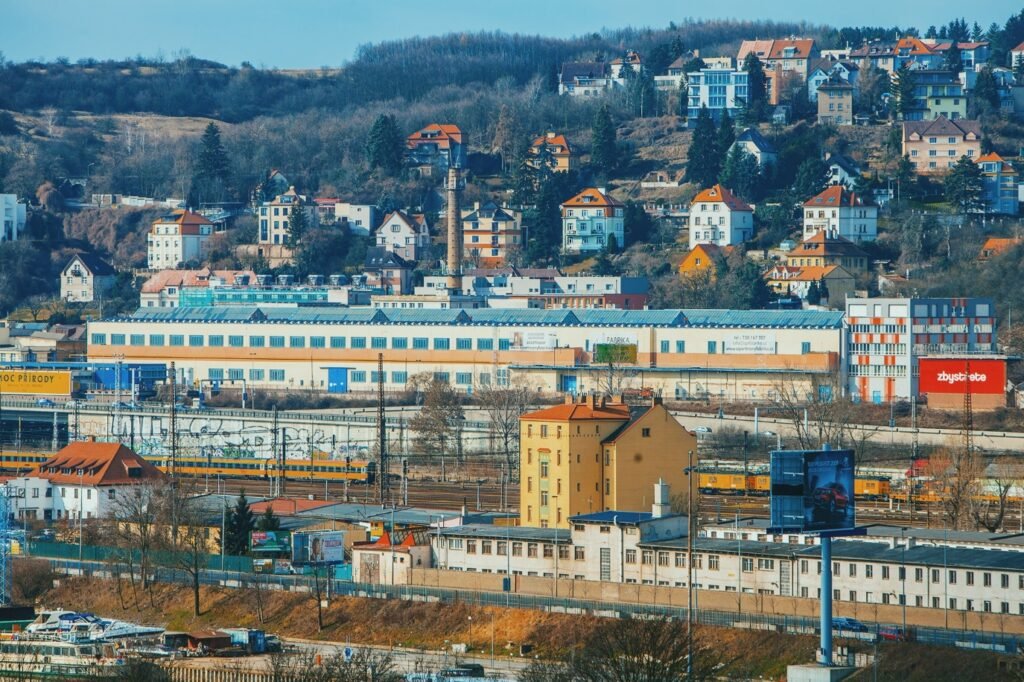
The Dancing House
Completed in 1996, the Dancing House features a design filled with curvy rhythms, with its twisting twin towers resembling a couple dancing together. That’s why it’s called the “Dancing House”—the left side is known as the “Dancer,” with a glass curtain wall that tapers like a flowing skirt, while the right side is the “Gentleman,” shaped like a cylindrical figure. Some even refer to it as “Ginger and Fred,” after the famous dance duo Ginger Rogers and Fred Astaire, as the building mimics their graceful dance moves.
In fact, this building serves as the headquarters for the Czech national insurance company, and the top floor houses a French restaurant where you can enjoy breathtaking views of Prague. This striking modern architectural piece was even featured on the cover of Lonely Planet, so it’s a must-see for fans of contemporary design!
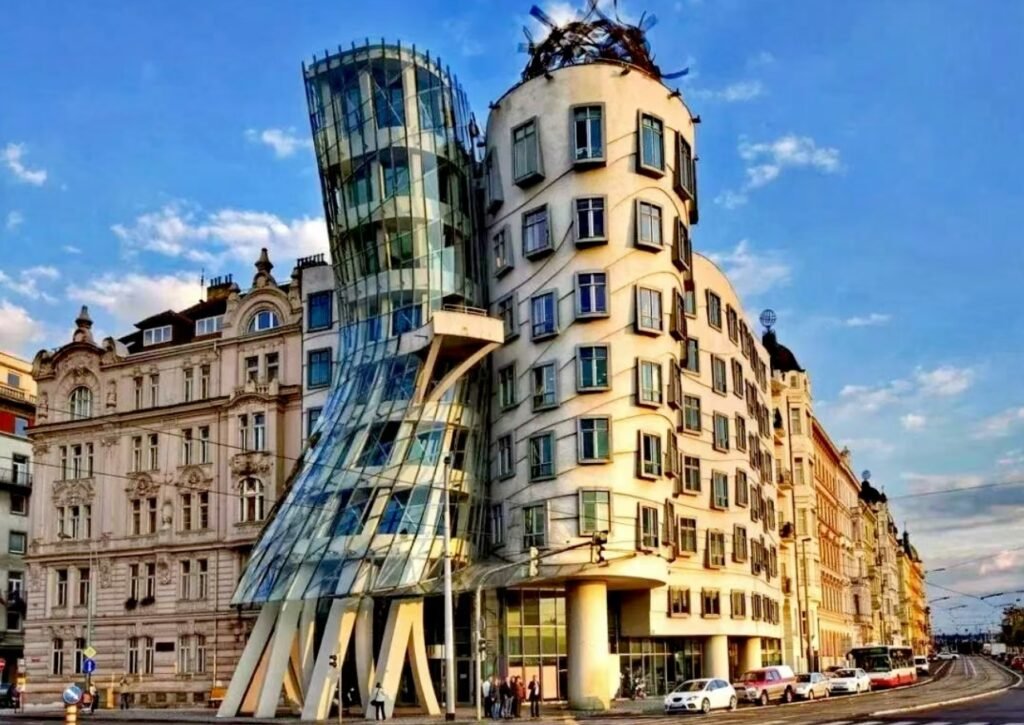
The Bone Church
The Bone Church, located in the town of Kutná Hora, about 75 kilometers southeast of Prague, has a fascinating yet macabre history. In the 14th century, the Black Death ravaged the area, followed by the Hussite Wars in the 15th century, leading to countless deaths in Bohemia. To appease the souls of the departed, devout priests decided to take the remains to Kutná Hora and bury them in sacred soil.
Later, the wealthy Schwarzenberg family purchased the land and church, and they had the idea to hire carpenter RINT to decorate the church. With a natural talent for geometric design and an abundance of human bones at his disposal, RINT decided to use skeletal remains as decoration. Thus, the Kostelík Vech savtych a kostnicí, or the Bone Church, was born. Inside, the decorations are entirely made from bones—lampstands crafted from skulls, shields made of stacked bones, altars constructed from skeletal remains, and even bone arrangements that spell out signatures. It’s a hauntingly beautiful sight!
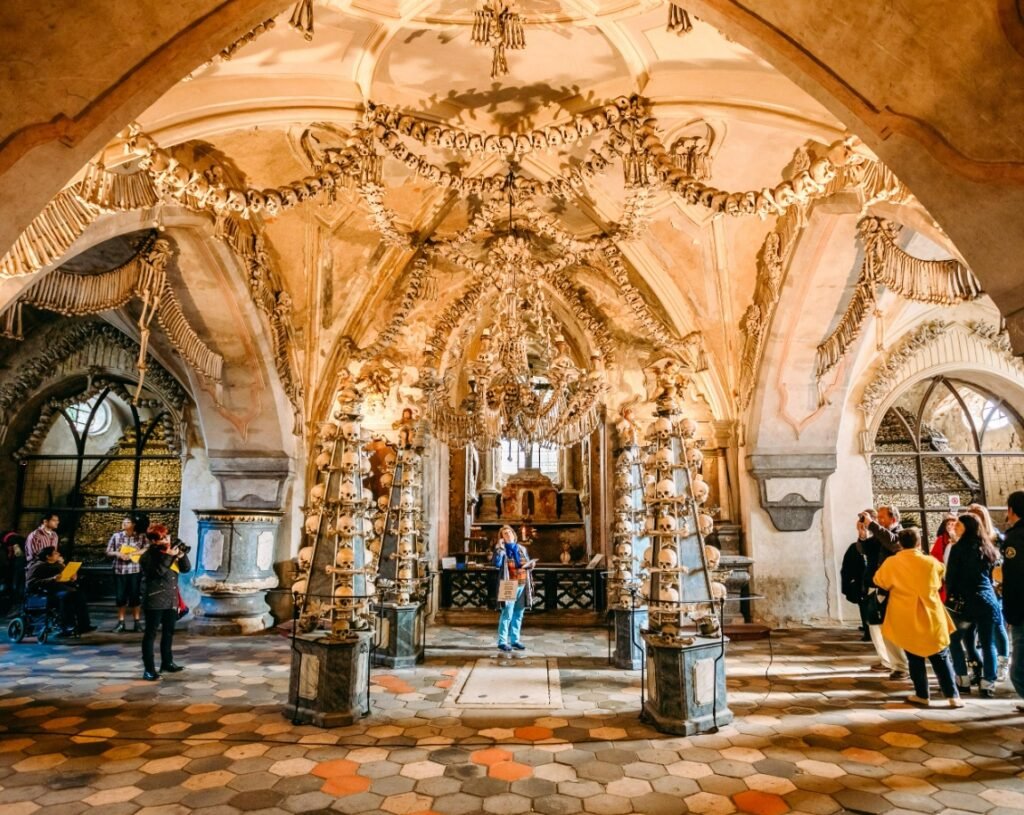
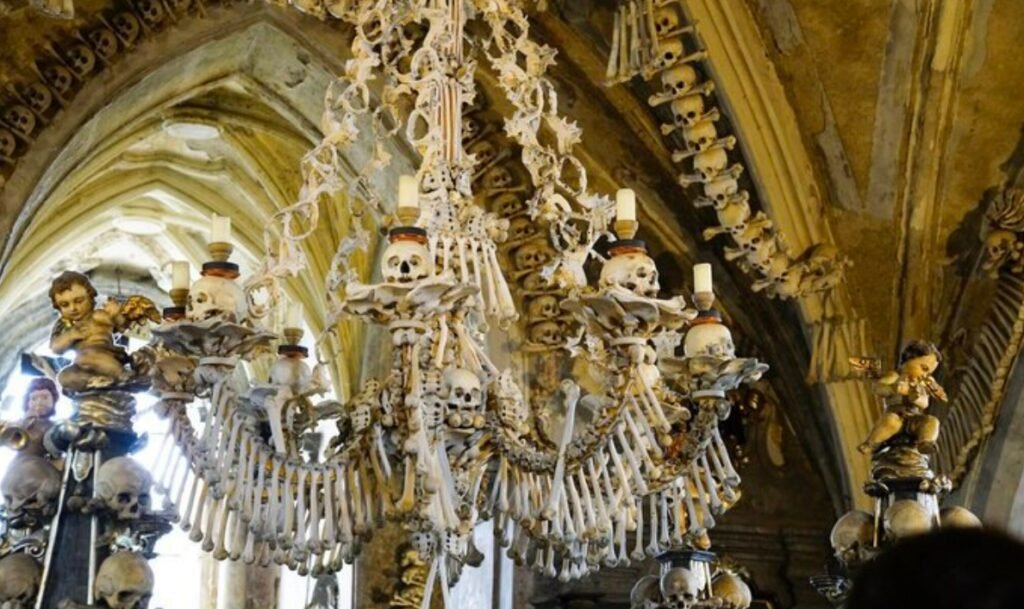
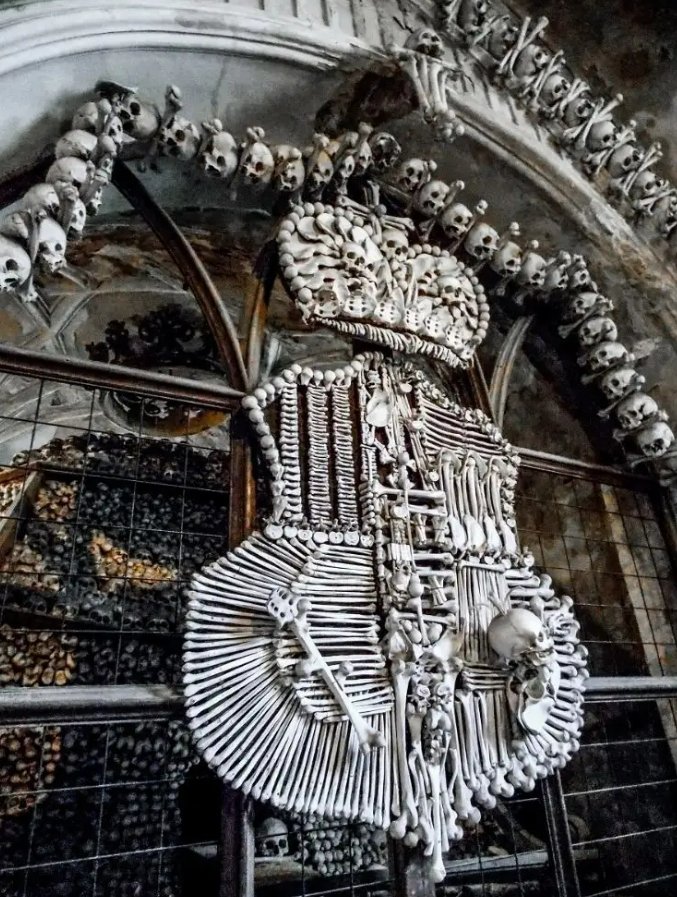
Accommodation Guide
Prague offers a range of lodging options, from luxurious five-star hotels to cozy guesthouses. You’ll find plenty of clean and comfortable hostels throughout the city, which are generally quite affordable and perfect for young backpackers. Most accommodations are concentrated in the Old Town, Jewish Quarter, and Lesser Town, making it easy to access the city’s major attractions. However, be aware that hotels in these areas tend to be on the pricier side.
Food Guide
Prague represents the purest culinary culture of the Czech Republic, boasting a rich variety of dishes influenced by its neighboring countries. Once localized, these dishes take on a unique flavor of their own. Compared to other European countries, restaurants in the Czech Republic offer great value, with a satisfying meal costing around 15-20 euros per person. In the Old Town, especially on the east bank of the Vltava River, you’ll find plenty of traditional Czech restaurants and family-run eateries. Just keep in mind that some places may add extra charges to your bill that aren’t technically tips, so at higher-end restaurants, it’s still customary to leave a gratuity.

Roast Pork Knuckle
Czech cuisine is known for its delicious meat dishes, and roast pork knuckle is a standout specialty. Almost every restaurant offers this dish, with a serving large enough for two people to enjoy a hearty meal. The pork knuckle is crispy on the outside and tender on the inside, bursting with flavor. Some restaurants even provide unique dipping sauces to enhance the experience. A visit to Prague wouldn’t be complete without trying this iconic dish!
Strolling Through Prague
Route Highlights: Prague is a romantic city where every inch seems to be imbued with poetry. To truly embrace this romance, strolling is the smartest way to explore. Pick a sunny day, grab your camera, and capture the beauty of every scenic spot—this is your unique Prague experience.
Morning:
Start your romantic day at the world’s largest ancient castle, where you can admire the artistic achievements of various historical periods. From the castle’s tower, you’ll get stunning views of Prague—definitely don’t miss it! Inside, St. Vitus Cathedral stands as a prime example of Gothic architecture, earning its title as a “gem of architecture.” As you stroll down the castle walls, take a moment to admire the breathtaking frescoes in St. Nicholas Church and visit Kafka’s former home at Golden Lane, number 22. Cross the historic Charles Bridge, leading you to the romantic heart of Prague—Old Town Square. Here, slow down and enjoy a local dish at a café, letting the vibrant surroundings enhance your meal.
Afternoon:
After a delicious lunch, let the bells of the Old Town Hall signal the start of your afternoon adventures. First, head to the haunting Týn Church, then follow the charming path to the Powder Tower, marking the end of your Old Town sightseeing. After a long day, don’t worry—take the metro to unwind. Wander around Wenceslas Square, sampling local snacks, before heading to the iconic Dancing House, a true modern art masterpiece. As the day winds down, make your way to Vyšehrad to catch a breathtaking sunset. That shot is sure to be one of your top memories!
Finally, stroll back to Old Town, find a cozy corner, and savor the day’s romantic journey. If time allows, consider visiting Kutná Hora the next day to see the famous Bone Church, adding another remarkable chapter to your Prague adventure!

